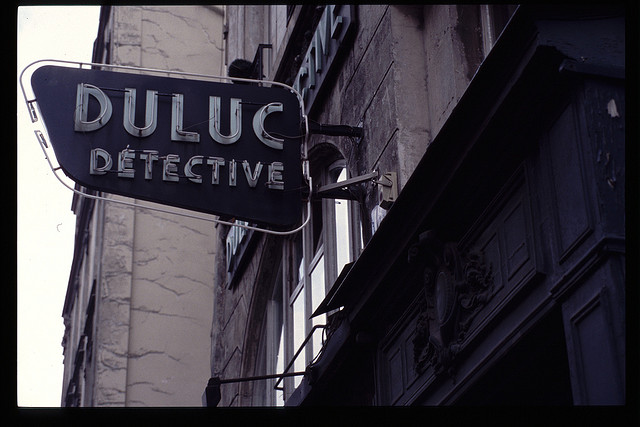
Parallelism
Using Parallel Structure
Begin by taking a few moments to watch this video on parallelism.
Access the file here if you would like to follow along with the video or print it to take notes.

"Parallelism," photo by Barbara K.
The period of the 1920s and 1930s is generally referred to as the Golden Age of Detective Fiction. During this period, a number of very popular writers emerged, mostly British but with a notable subset of American and New Zealand writers. Female writers constituted a major portion of notable Golden Age writers, including Agatha Christie, the most famous of the Golden Age writers, and among the most famous authors of any genre, of all time. Four female writers of the Golden Age are considered the four original "Queens of Crime": Christie, Dorothy L. Sayers, Ngaio Marsh and Margery Allingham. Apart from Ngaio Marsh a (New Zealander) they were British.
Various conventions of the detective genre were standardized during the Golden Age, and in 1929 some of them were codified by writer Ronald Knox in his 'Decalogue' of rules for detective fiction, among them to avoid supernatural elements, all of which were meant to guarantee that, in Knox's words, a detective story "must have as its main interest the unravelling of a mystery; a mystery whose elements are clearly presented to the reader at an early stage in the proceedings, and whose nature is such as to arouse curiosity, a curiosity which is gratified at the end." In Golden Age detective stories, an outsider — sometimes a salaried investigator or a police officer, but often a gifted amateur — investigates a murder committed in a closed environment by one of a limited number of suspects.
The most widespread subgenre of the detective novel became the whodunit (or whodunnit, short for "who done it?"), where great ingenuity may be exercised in narrating the events of the crime, usually a homicide, and of the subsequent investigation in such a manner as to conceal the identity of the criminal from the reader until the end of the book, when the method and culprit are revealed. According to scholars Carole Kismaric and Marvi Heiferman, "The golden age of detective fiction began with high-class amateur detectives sniffing out murderers lurking in rose gardens, down country lanes, and in picturesque villages. Many conventions of the detective-fiction genre evolved in this era, as numerous writers — from populist entertainers to respected poets — tried their hands at mystery stories."
Many of the most popular books of the Golden Age were written by Agatha Christie, who produced long series of books featuring her detectives Hercule Poirot and Miss Marple, amongst others, and usually including a complex puzzle for the reader to try to unravel. Christie's novels include, Murder on the Orient Express (1934), Death on the Nile (1937), and And Then There Were None (1939). Also popular were the stories featuring Dorothy L. Sayers's Lord Peter Wimsey and S. S. Van Dine's Philo Vance.
The "puzzle" approach was carried even further into ingenious and seemingly impossible plots by John Dickson Carr — also writing as Carter Dickson — who is regarded as the master of the "locked room mystery", and Cecil Street, who also wrote as John Rhode, whose detective, Dr. Priestley, specialised in elaborate technical devices, while in the US the whodunnit was adopted and extended by Rex Stout and Ellery Queen, among others. The emphasis on formal rules during the Golden Age produced a variety of reactions. Most writers were content to follow the rules slavishly, some flouted some or all of the conventions, and some exploited the conventions to produce new and startling results.
from "Detective Fiction." Wikipedia: The Free Encyclopedia. Wikimedia Foundation, Inc. 22 July 2004. Web. 06 Jan. 2014.
Show/hide comprehension question...
Show/hide comprehension question...
Show/hide comprehension question...
Show/hide comprehension question...
Show/hide comprehension question...

"Duluc Detective," photo by Pete Reed
Martin Hewitt, created by British author Arthur Morrison in 1894, is perhaps the first example of the modern style of fictional private detective.
By the late 1920s, Al Capone and the Mob were inspiring not only fear, but piquing mainstream curiosity about the American underworld. Popular pulp fiction magazines like Black Mask capitalized on this, as authors such as Carrol John Daly published violent stories that focused on the mayhem and injustice surrounding the criminals, not the circumstances behind the crime. From within this literary environment emerged many stories and novels about private detectives, also known as private investigators, PIs and "private eyes" ("eye" being the vocalization of "I" for "investigator"). Very often, no actual mystery even existed: the books simply revolved around justice being served to those who deserved harsh treatment, which was described in explicit detail."
In the 1930s, the private eye genre was adopted wholeheartedly by American writers. The tough, stylish detective fiction of Dashiell Hammett, Jonathan Latimer, Erle Stanley Gardner and others explored the "mean streets" and corrupt underbelly of the United States. Their style of crime fiction came to be known as "hardboiled", which encompasses stories with similar attitudes concentrating not on detectives but gangsters, crooks, and other committers or victims of crimes. "Told in stark and sometimes elegant language through the unemotional eyes of new hero-detectives, these stories were an American phenomenon."
In the late 1930s, Raymond Chandler updated the form with his private detective Philip Marlowe, who brought a more intimate voice to the detective than the more distanced, "operatives report" style of Hammett's Continental Op stories. Despite struggling through the task of plotting a story, his cadenced dialogue and cryptic narrations were musical, evoking the dark alleys and tough thugs, rich women and powerful men about whom he wrote. Several feature and television movies have been made about the Philip Marlowe character. James Hadley Chase wrote a few novels with private eyes as the main hero, including Blonde's Requiem (1945), Lay Her Among the Lilies (1950), and Figure It Out for Yourself (1950). Heroes of these novels are typical private eyes very similar to Philip Marlowe.
Ross Macdonald, pseudonym of Kenneth Millar, updated the form again with his detective Lew Archer. Archer, like Hammett's fictional heroes, was a camera eye, with hardly any known past. "Turn Archer sideways, and he disappears," one reviewer wrote. Two of Macdonald's strengths were his use of psychology and his beautiful prose, which was full of imagery. Like other 'hardboiled' writers, Macdonald aimed to give an impression of realism in his work through violence, sex and confrontation; this is illusory, however, and any real private eye undergoing a typical fictional investigation would soon be dead or incapacitated. The 1966 movie Harper starring Paul Newman was based on the first Lew Archer story The Moving Target (1949). Newman reprised the role in The Drowning Pool in 1976.
Michael Collins, pseudonym of Dennis Lynds, is generally considered the author who led the form into the Modern Age. His PI, Dan Fortune, was consistently involved in the same sort of David-and-Goliath stories that Hammett, Chandler, and Macdonald wrote, but Collins took a sociological bent, exploring the meaning of his characters' places in society and the impact society had on people. Full of commentary and clipped prose, his books were more intimate than those of his predecessors, dramatizing that crime can happen in one's own living room.
The PI novel was a male-dominated field in which female authors seldom found publication until Marcia Muller, Sara Paretsky, and Sue Grafton were finally published in the late 1970s and early 1980s. Each author's detective, also female, was brainy and physical and could hold her own. Their acceptance, and success, caused publishers to seek out other female authors.
from "Detective Fiction." Wikipedia: The Free Encyclopedia. Wikimedia Foundation, Inc. 22 July 2004. Web. 06 Jan. 2014